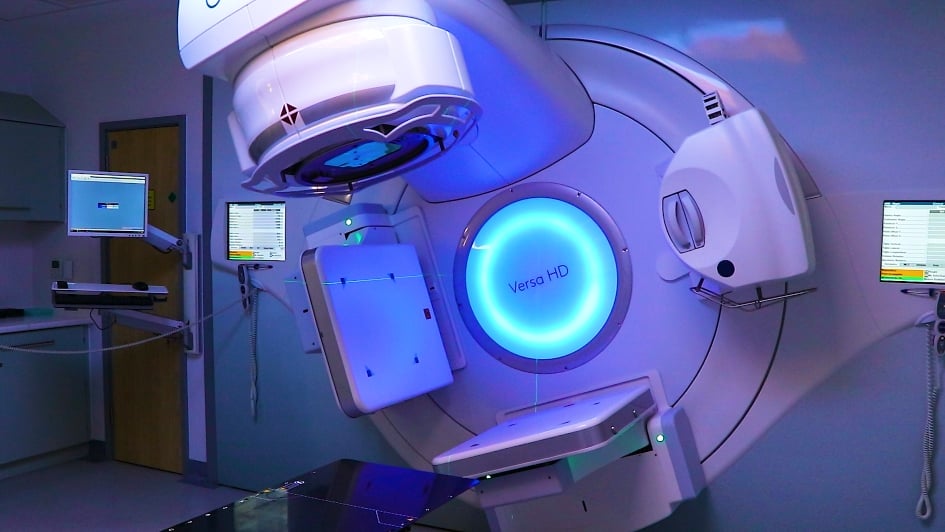
Researchers have used real-time MRI scans to prove swallowing causes minimal risk in people undergoing radiotherapy sessions for cancer in the larynx.
This finding supports improvement for the process of measuring motion during radiotherapy, which could be expanded to other areas affecting the head and neck – future research could assess whether treatment margins need to be adjusted to account for movements of the tongue, according to the Institute of Cancer Research.
The research was conducted by the Institute of Cancer Research (ICR), London, and The Royal Marsden NHS Foundation Trust led the study, which was funded by Cancer Research UK, and the findings were published in the journalAdvances in Radiation Oncology.
Risks of radiotherapy
For this study, research focused on early-stage glottic cancer (ESGC), a type of head and neck cancer which affects the middle region inside the larynx.
Risks from radiotherapy mean many treatment centres have switched from conventional three-dimensional conformal radiotherapy (3D-CRT) radiotherapy to more conformal radiotherapy, which better shapes the radiation beams to match the tumour in an attempt to spare the surrounding tissue.
However, strategies to spare healthy tissue from radiation must be balanced against the need to destroy the cancerous cells, the ICR said. Findings from this study could lead to better patient outcomes in the long-term, because understanding the internal movements of the body helps to determine the target area for irradiation.
“For cancers of the head and neck, swallowing motions can also temporarily affect the position of the tumour,” the research found. “Until now, there has been little research into whether these movements are significant enough to warrant adding larger safety margins to the treatment volume.”
Worst-case estimates
The study used the MR Linac unit based at the Sutton site of the ICR and The Royal Marsden, which can perform MRI scans and deliver radiotherapy at the same time. This allowed visualisation and measurement of the vocal cords surrounding the glottis.
By recording measurements at the beginning, middle and end of treatment in 15 patients with ESGC, they found swallowing caused up to 2.48cm of movement in the tumour, but the rate and duration of swallowing was low enough that they were deemed “clinically insignificant”.
Even with a worst-case estimate, more than 95 per cent of the radiotherapy dose treated the furthest displacement to which the tumour could be moved.
Researchers then checked dose delivery to thyroid glands and carotid arteries, compared treatment plans across radiotherapy types, and confirmed that smaller target areas were the best option for limiting damage to healthy tissue.
Visualising movement
In the next part of the study, the researchers checked the dose delivery to organs at risk, including the thyroid glands and carotid arteries. They compared treatment plans for 3D-CRT, which targeted the whole larynx, with those for IMRT, which targeted only the internal target volume (ITV - the safety margin around the edges of the tumour, allowing treatment to continue being effective should the tumour move slightly). They also looked at two types of VMAT plans – one that targeted the whole larynx and one that was adapted to treat the ITV.
First authorDr Amit Gupta, clinical oncology consultant in Head and Neck at the Mount Vernon Cancer Centre in London, who carried out the work when he was a Clinical Research Fellow at the ICR and The Royal Marsden, explained that the study has demonstrated it is possible to deliver conformal radiotherapy safely in ESGC.
He said: “Other studies have looked at laryngeal motion using MRI before, but they have not had access to MR-Linac. With this technology, we were able to visualise the movement of the voice box. The degree of motion we could see, even when patients were at rest, was astonishing. Encouragingly, our findings were consistent with previous research, confirming the strength of our real-time approach.
“The clinical insignificance of swallow-related motions is good news for patients, as it means we can spare critical organs at risk, including the carotid arteries. We hope that in the longer term, we will be able to further reduce the irradiated volume by removing the ITV completely.”
Professor Kevin Harrington, head of the Division of Radiotherapy and Imaging at the ICR, also worked on the study.
He said: “Our work has confirmed that accounting for resting motion in an ITV is sufficient, which supports a move towards more conformal target volumes that can significantly reduce the risk of damage to vital organs. By sparing the carotid arteries and thyroid gland, we can help more patients avoid conditions affecting the flow of blood to the brain.”
(Image: MR Linac, via the Institute of Cancer Research)
